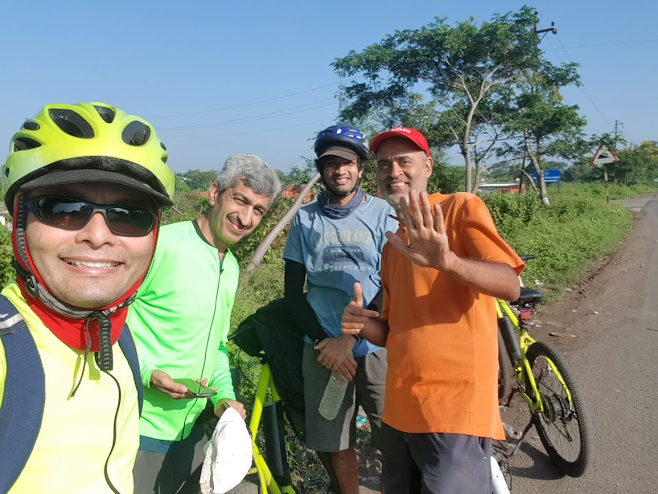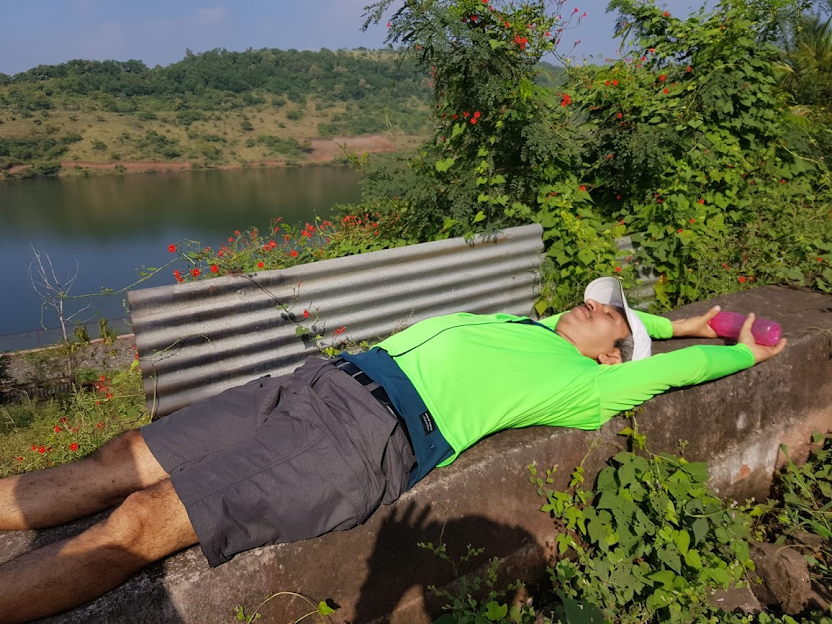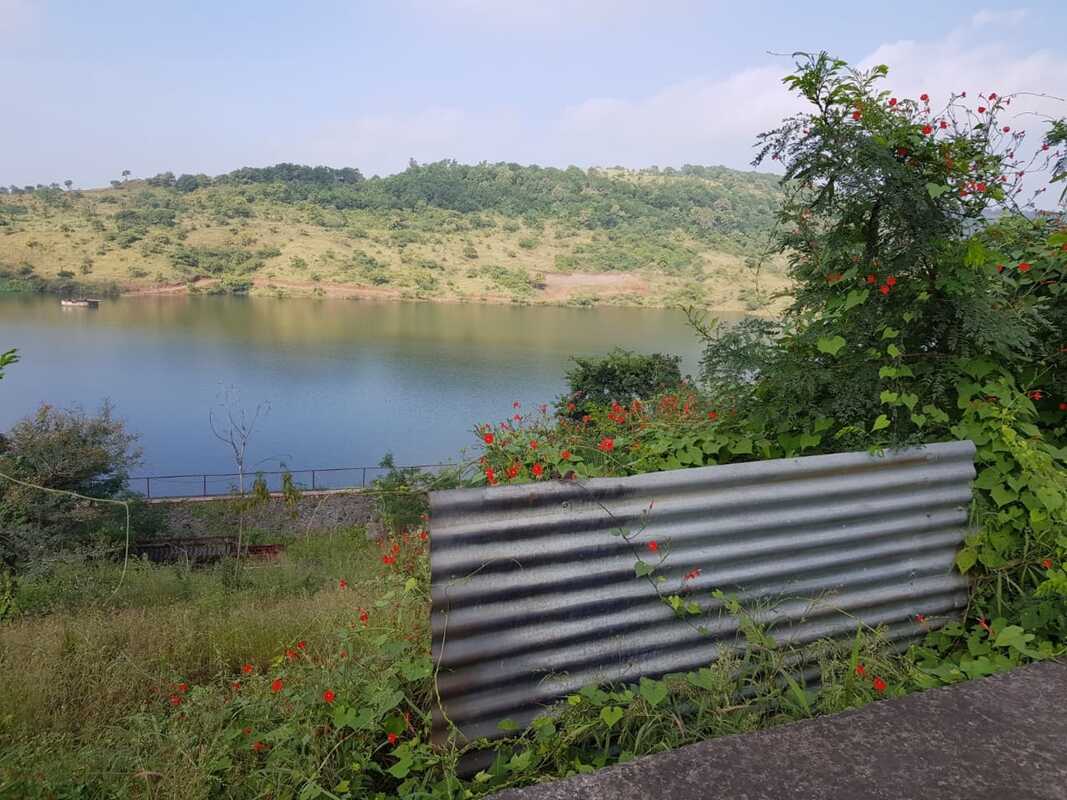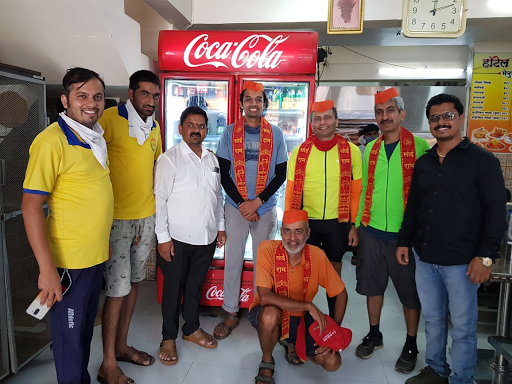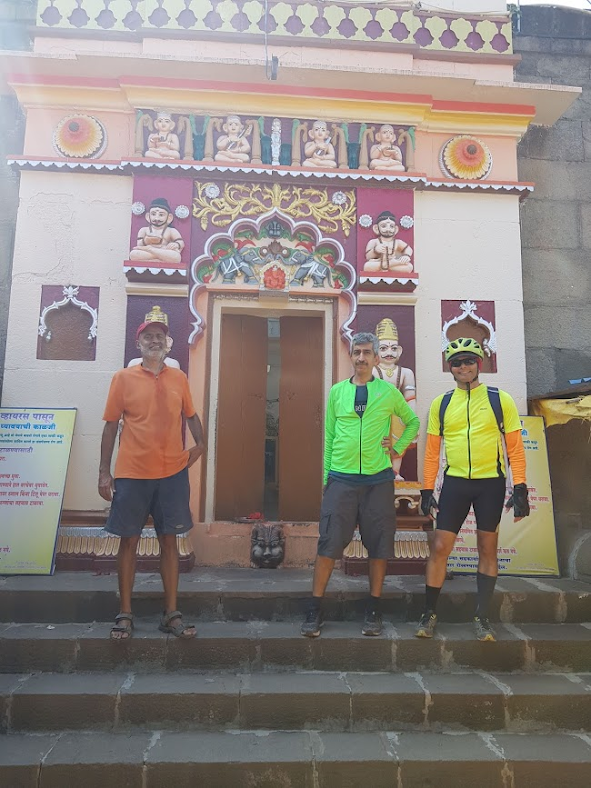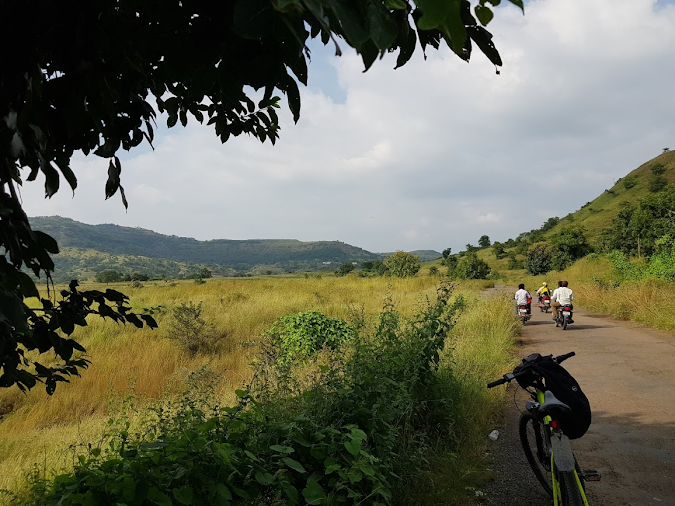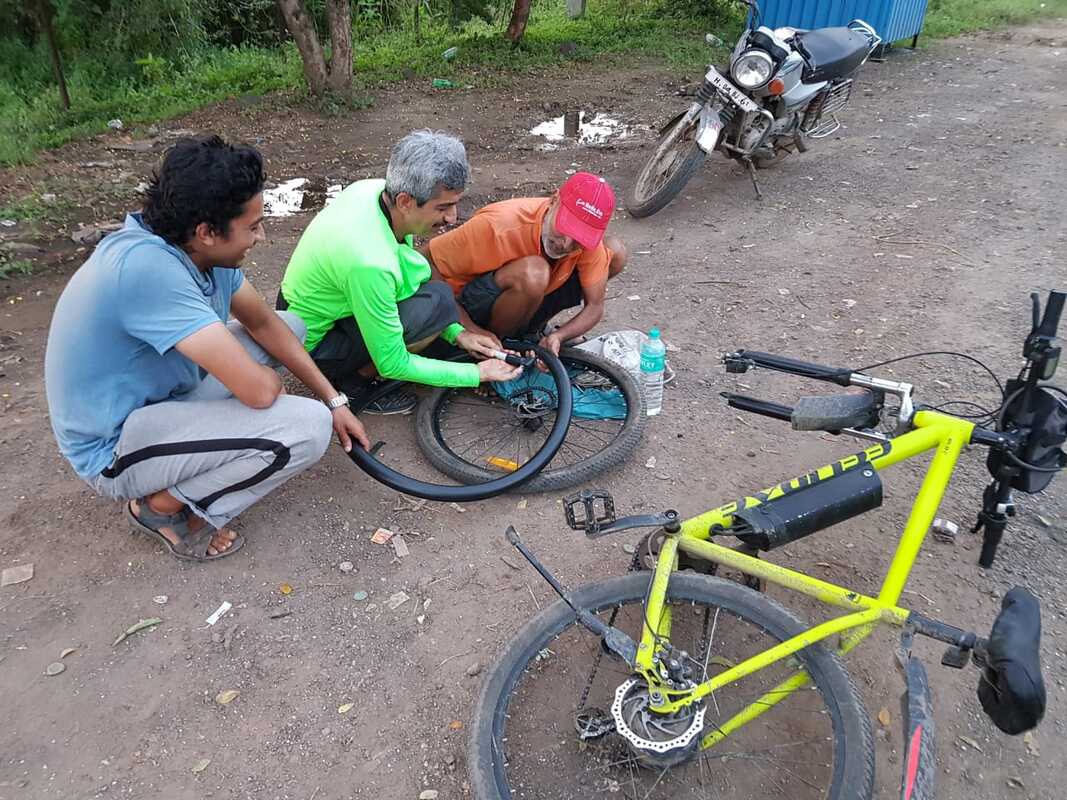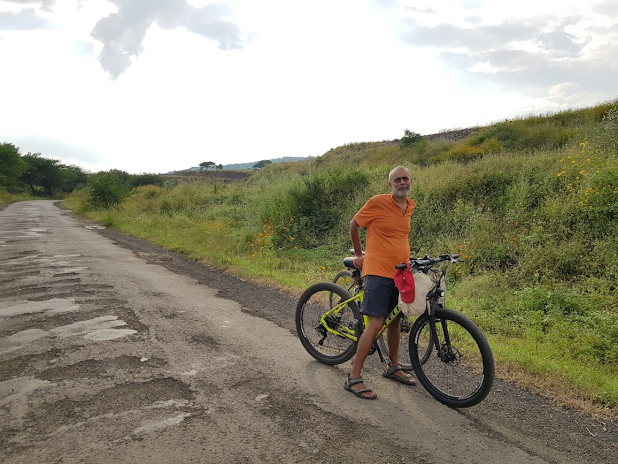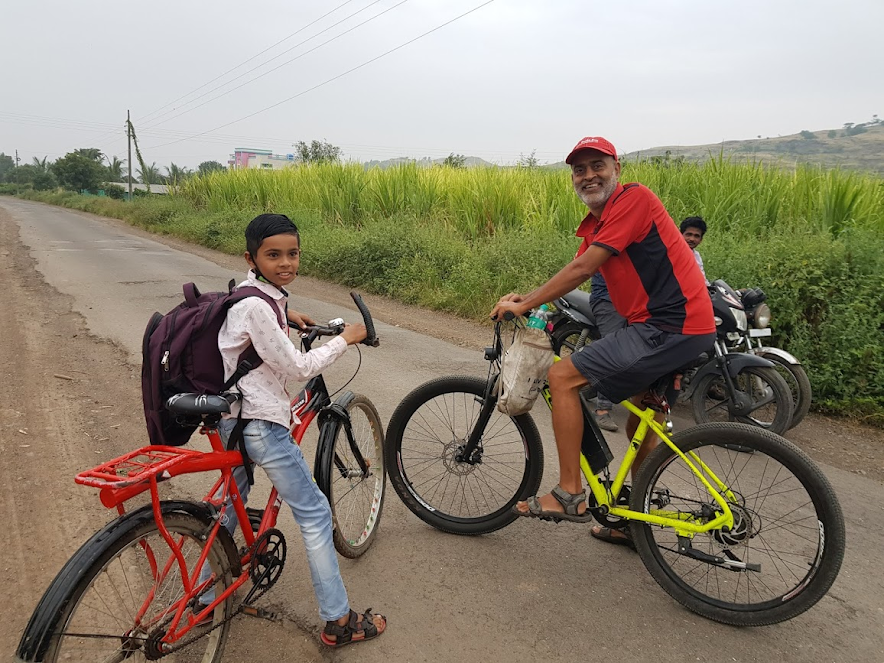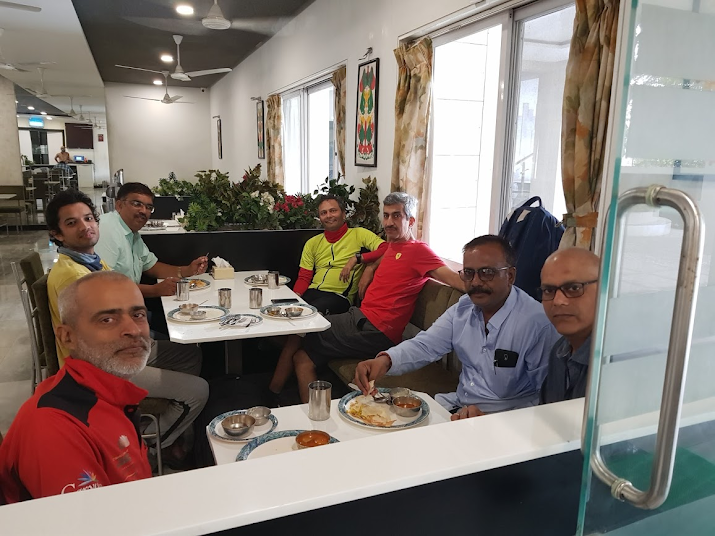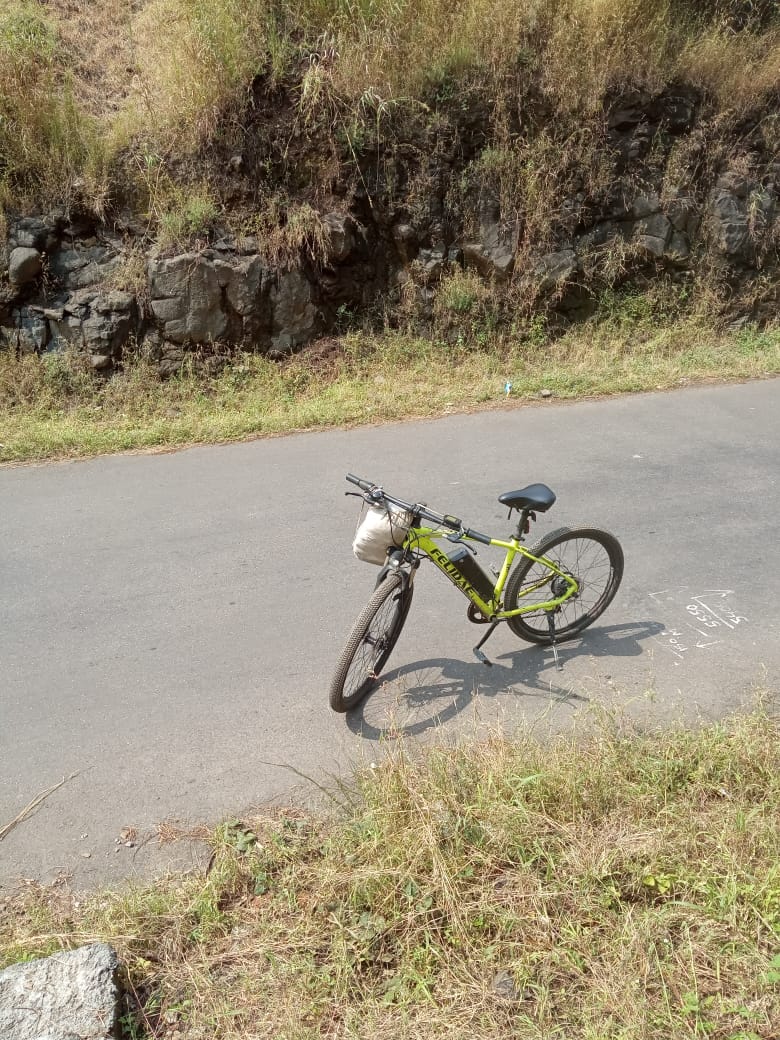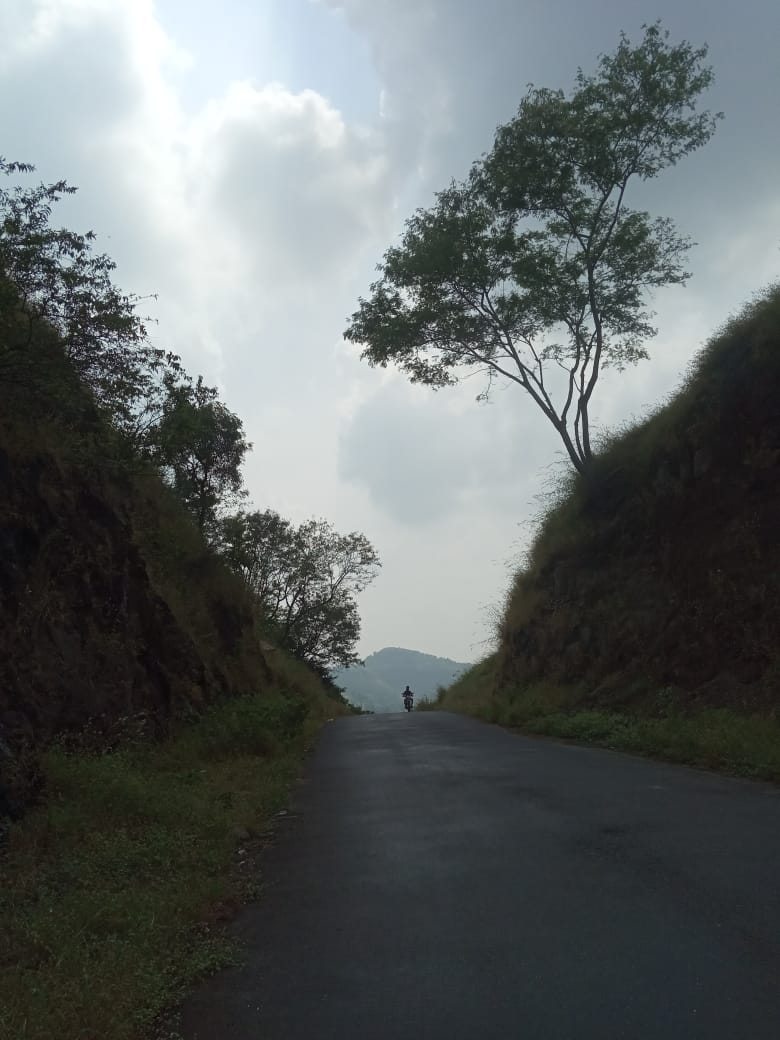One thing that works best for the tummy in cycle rides is fruit. We followed this diet all the way to Narayangaon, having oranges, apples, bananas, papaya and coconut juice enroute. (Confession: I also hogged on two matar karanjis from Green Bakery.) In hindsight, carrying a bag full of fruit for the trip was a bad idea. On busy highways like the Pune Nasik road, there are no worries about fruits, as you have fruit stalls every few km. Later on when we switched to village roads, the stall density reduced, but still every village did have a fruit stall or two.
My contribution to the local economy was to lose my water bottle. We took a 1 km detour for Ganesh Door darshan. The only competition to the 4 cycles for the darshan, was a newly purchased Maruti Ertiga, which was being pampered by a poojary. We tried our best to get close enough to be gifted Chitale pedas which were the prasadam, but the poojary ignored us – no dakshina, no prasadam.
Out next pitstop was the small town of Otur, which continued to see mostly good roads. Otur is on the Alephata Kalyan highway, about 15 km from Alephata. We took a right turn towards Alephata and turned left at the ST stand, to hit the Brahmanwada road. The topography started changing. The tractors got smaller and the fields greener. As we waited for Anil to catch up, we spied a pile of cucumbers that had been dumped by the roadside. We picked up 4 – and went to the owner of the house next door to enquire if we can wash this stolen stuff. She laughed us off – and assured that no water required, we could eat them just like that. She said it was without favara, implying no insecticide spray had been used. Enjoyed the cucumber in the 1500 hrs heat – and wonder why those got dumped in the first place. I thought that they would be waiting for transport to the market, but when I cycled past 4 days later, I noted the heap still lying there in the same location.
A few km beyond Otur started the 12 km climb to Brahmanwada. Here is where my planning deficiency started showing. Had not factored in elevation in setting our distance target for the day. The 12 km took 1.5 hours to climb, even with motors on. Samir managed to match speed with the rest of the motor bhais, and we reached Brahmanwada at 1630 hrs. Brahmanwada is a village with dairy farming as the main economy driver. Anil’s battery juice had all been sucked out in the climb. Swapped batteries with him to reduce some of his range anxiety. Took a snack break after the climb with the menu being: wada pav, biscuits and jalebi. The breakfast bill totalled to a grand sum of Rs 46. The stall owner donated a used mineral water bottle, which I added to my armoury, having forgotten my old one at Ozar.
We asked around and were told that Dhamangaon Pat has two tyre shops. In the interim, the small air pump helped as Anil could limp on. On reaching Dhamangaon, we found both puncture shops closed. Fortunately it was the front tyre that was punctured and I was carrying a spare tube, which helped get Anil back on track. The front wheel can be removed without tools, but in electric cycles, the rear tyre can be removed only with the help of appropriate spanners. Note to myself: next time carry the patches and rubber solution. Or carry the appropriate spanner.
We reached our night stay destination, Akole at 1930 hrs. Had been able to google and get the contact details of only one Akole hotel – Gurukripa. Did some small bargaining and managed to get the tariff reduced from 1300 to 1000, by playing the senior citizen card. The general consensus amongst people who see me but don’t know me is that I am a sprightly 65 year old. I like to encourage that impression – as it helps justify my semi-retired life. Had a lovely hot water bath. Strava informed us that we had done 147 km and a 1400 m elevation gain on day 1. Baptism by fire for both Anil and Dev. For both of whom this was their first long ride. Their spirits were high – and Anil decided that he can remain beer less and Dev supported the high spirited moment by going whiskey less. Instead all of us trooped into Pooja Bhojnalaya and enjoyed their special thali with shrikhand. (gulab jamun for Anil bhai.)
We had planned a 0600 hrs departure the next day. But at 0545 hrs we realised that Anil and Dev were still recovering from their cycling hangover. For me, the new seat with springs under the saddle helped. Found my back aching less. Though the legs did pain. We managed to finally start off at 0630 hrs. The first 15 km till Dapur was rolling terrain. In between we stopped at a small village hamlet to fill up the air in Anil’s front tyre. The 147 km ride had increased my already high metabolism rates. Had had some sweet potatoes and apples before starting, but was famished by 0800 hrs. We stopped at Dapur to buy the world’s best energy bar – bananas. From Dapur it was a gently sloping road all the way down to the Pune Nasik highway, which we joined 9 km before the start of the Sinnar bypass.
It was a Narayangaon deja vu at Sinnar. My friend Kamlesh Mundada had spread the news of our arrival to the local cycling community. And 4 of them landed up to greet us at Hotel Panchavati, opposite the ST bus stand. Like Narayangaon, the Sinnar cyclists are also a hyperactive lot. 500 Nasik cyclists do a Pandharpur ride every year, with about 60 joining from Sinnar. We had a lovely masala dosa at the restaurant at Panchvati Hotel. Should have stopped at one dosa, but got carried away by Dev’s metabolic powers and shared half an additional uttapa with Anil. With diminishing marginal utility. The dosa was definitely tastier. Cycling energy was halved with all the calories. With only 18 km to go for the ride finish, and a 75 % SoC battery, powered on the motor to level 3 and sped on to Nasik.
Checked in at Hotel Anand near the Nasik road railway station. Lunch was at Nandini Woodland restaurant at Nasik Klub, with COEP friends, Prajakta Mehta and Ajay Gosavi. Anil’s son Neerav joined us for lunch, having driven down Samir’s Honda City from Pune. Samir’s cycle was dismantled and loaded in the car’s boot. As we waited for Samir to join back after meeting his Nasik family council, 4 engineers tried to install the cycle carrier on the dicky. 2 configurations were experimented with. Only to find Samir showing us a third one after he landed up. Samir, Dev and Anil, along with their cycles reached Pune at 2200 hrs, ready to show up for work on Monday morning.
Lost my way out of Sinnar and started going to Shirdi – which is the broadest road out of town. Realised the mistake a km later and did a U turn. Enroute, found a board that said – Dapur – 9 km. Realised that it is the same village where we had had a banana break on our Pune Nasik journey. Quick decision was taken about return via village roads vs highways. Decided that braving the leopards was better than braving the madmen in their speeding cars. Took the village road. The first 4 km of the Dapur road was ok, but in the next 5 km it became a kaccha road. Passed a 6 lane road under construction – guess that must have been the new Mumbai Nagpur expressway. At one point, had to wade through a fast flowing wide stream which was meandering on the road.
From Dapur onwards, the road was the same familiar one that I had used in the Pune Nasik ride. Reached Akole at 1100 hrs. Too early for lunch. And with only 10 km of battery riding done, decided to risk the ghat climb. Locals told me to avoid the Lingadev route, so stuck to the usual Dhanamgaon Pat climb. Was a bit hot by then. Restricted motor assist level to 1 at the start. There were quite a few sections though, where I had to go to level 3. Most of these sections are when you take an inner turn at a jalebi mor. As with most ghats, as you near the summit gradient percentages go up. Had to end up using more of assists level 2 as the climb neared its end. The average climb speed was 5 to 6 kmph. Took an hour to reach the summit. Stopped there and finished off two oranges. Should have hydrated better, but the water bottle was buried under a lot of stuff in the bag.
At 1215 hrs, reached Dhamangaon Pat village. Went to the same guy where we had charged Anil’s battery on Saturday evening. But our friend only serves snacks. Decided to cycle on to Kotul – which is mostly downhill. Most Kotul eateries were also serving only snacky stuff. Was advised that you can get regular food at dhabas on the Brahmanwada road. Stopped at the first one that came – Saileela. The guy remembered seeing us cycling past on Sat and was ok with battery charging. Ordered green peas, tandoori roti and rice-dal. Must make it a point to order the non gravy version of veggies. They tend to be more palatable. Had a lot of time to eat, as the battery also required feeding. Started with 50% SoC and ended up with almost a 100% SoC.
Started the climb to Brahmanwada at 1345 hrs. Weather was better as it had become slightly cloudy. Given the cyclonic conditions in Pune the previous week, was surprised that I did not come across even a drop of rain in the entire trip. Reached Brahmanwada around 1445 hrs. Took the usual jalebi break and carried on to Otur. Crossed Otur at 1530 hrs. Did not stop. The next break was at 1600 hrs at Ozar for the usual sugarcane juice. Was informed that the bottle that I had left behind had been commandeered by a guy who needed a bottle to fill motor spirits.
Reached Narayangaon at 1645 hrs. Thought it too early to wind up. So decided that night stay could be at Manchar, 11 km down the road. Reached Manchar at 1730 hrs. Decided that one more hour of daylight could afford one more hour of cycling. The next major town was Khed, 19 km away. Had 2 bars of battery – so used the battery. Khed is at a lower elevation – so got a good average speed and reached Khed at 1830 hrs. Hotels were aplenty, but Pune was only 40 km away, so decided on doing a one hour charge and a night ride to reach home.
All the restaurants near the bus stand seemed to be the mutton thali ones. My criterion was charging, not food, so ended up having my usual veg fare in one of those. Had an unappetizing bhakri-matki on the first floor of this restaurant. Made some small talk with the security guy on the ground floor to kill some more time. At 1935 hrs, disconnected the battery and started the last stretch. Unfortunately the tail lamp was not working. Strong advice to the Felidae team would be to get a tail lamp as standard fitment. It can share the same power switch as the front lamp. The battery SoC showed only 2 bars, so I was worried. Did the first 20 km slowly, as there were no street lights – and did not want to risk cycling in the dark if the LED headlamp died out. Streetlights happened around Moshi and speed went up as a result. At Bhosari, the battery came loose again – and had to stop to put it back in. After the refixing, bars bounced back to 2. Used the Level 2 assist from then on – and averaged 20-25 kmph to reach home at 2155 hrs.
This was my first long ride with an electric cycle, so sharing the experience of the Felidae Electric. First the mechanicals. The retrofitted underseat spring saddle helped with comfort. The Textro brakes were superb. Never felt unsafe on the downhill ghat sections. The Zoom front fork worked well – though there was still some hand pain because of the poor quality of village roads. Having 2.75 inch width Kenda tyres helped in improving comfort. There were times when I felt that the bottom bracket sound was coming back. Had got it changed just before we started the trip. But the sounds vanished on their own. The battery locking needs to be looked at – could have exploded if a truck were to crush it.
Now coming to the electricals. There was some moisture inside the LED display module, as it did rain when the cycle was parked in the open outside the Nasik hotel. A better SoC meter is required. Very difficult to plan pit stops otherwise. Rear tail lamp is a must. Visibility is critical for the commuter – especially after sundown or during the early morning hours. Level 1 ride in ghat had an uncomfortable motor vibration. It goes away as motor rpm increases, but at higher levels of assist, one is scared of how much battery juice would remain.
On the Pune Nasik journey the total elevation gain was 1700 m. Energy required to lift a 90 kg load (rider plus luggage plus cycle) is mgh = 90*10*1700 = 1500 kJ or 1500/3600 kWh = 0.42 kWh. This does not include rolling or aerodynamic friction. The Felidae battery is 36 V, 5.2 Ah, so it can store about 0.18 kWh. If I were to use solely motor traction for the climbs, I would require charging for three to four times. One less, if you start with a fully charged battery. There may be an emerging market of leisure bikers who want to do long weekend rides. Bigger batteries would make sense for such a target audience.
My friend's Samir blog

